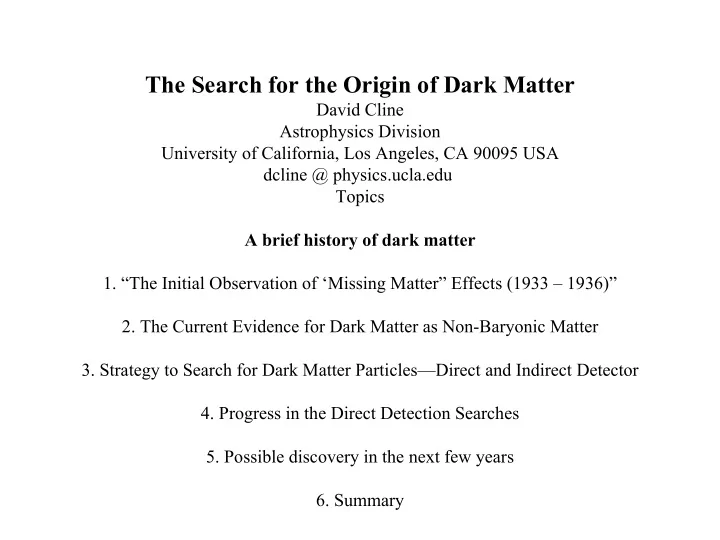

The Search for the Origin of Dark Matter David Cline Astrophysics Division University of California, Los Angeles, CA 90095 USA dcline @ physics.ucla.edu Topics A brief history of dark matter 1. “The Initial Observation of ‘Missing Matter” Effects (1933 – 1936)” 2. The Current Evidence for Dark Matter as Non-Baryonic Matter 3. Strategy to Search for Dark Matter Particles—Direct and Indirect Detector 4. Progress in the Direct Detection Searches 5. Possible discovery in the next few years 6. Summary
Methods to Search for Dark Matter (WIMPS) Direct: Scatter from atom recoil gives signal; rate goes like A2 Large Detector: CDMSII, Super CDMS, Edelweiss, CRESST, ZEPLIN, XENON, WARP, LUX Indirect: Detect products of WIMP interactions in the galaxy with characteristic properties γ , e+, , p d Detectors: GLAST, PAAMELA, AGILE, GAPS, AMS, ICECUBE, SUPER K, etc.
CDMS Direct Detection
Expected sensitivity – 5Towers
XENON10, ZEPLIN II results
Status and Prospects for the Search for WIMP Dark Matter σ ~ 10 -7 pb limit [CDMS, XENON 10, ZEPLIN II] Current 2007 σ ~ 10 -8 pb limit [Same as 2007 and ZEPLIN II, 2008 Expect ? WARP 140] σ ~ 10 -9 pb search [LUZ, Super CDMS, 2008-2010 2008-2010 EURECA] Current theory estimate: σ ~ 10 -8 – 10 -9 pb for signal
Recommend
More recommend